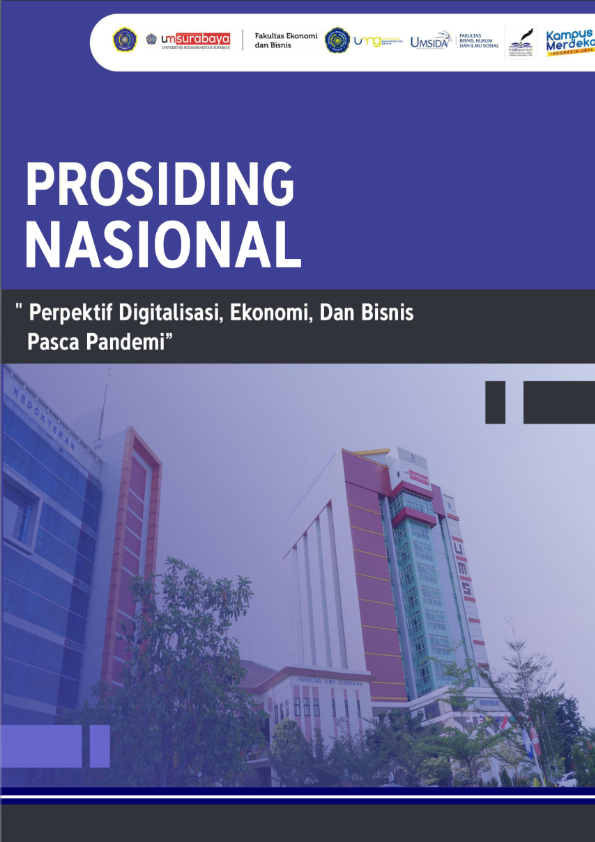PENGARUH HUTANG JATUH TEMPO TERHADAP KONSERVATISME AKUNTANSI
Abstrak
This research aims to determine the effect of maturing debt by adding control variables, namely, leverage, size, profitability on accounting conservatism. Samples were taken using a purposive sampling technique totaling 92 companies in non-financial companies listed on the Indonesia Stock Exchange in 2019. The data analysis techniques used were descriptive statistics, classical assumption tests, and multiple linear regression analysis. The results showed that the independent variable short term debt maturity, leverage and size control variable, had no effect on accounting conservatism. Based on the results of the interpretation of the independent variables in this study, it is hoped that researchers can add the Long Term Debt Maturity variable as a comparison with the Short Term Debt Maturity variable in the hope of proving more accurate research and producing data significance. While the control ROA have an effect on accounting conservatism.
Keywords:Short Term Debt Maturity; Leverage; Size; ROA; Accounting Conservatism.Â
Referensi
Almilia, L. S. (2006). Prediksi Kondisi Financial Distress Perusahaan Go-Public dengan Menggunakan Analisis Multinomial. Jurnal Ekonomi Dan Bisnis.
Almilia, Luciana Spica, & Sulistyowati, D. (2007). Analisa Terhadap Relevansi Nilai Laba, Arus Kas Operasi, dan Nilai Buku Ekuitas Pada Periode Disekitar Krisis Keuangan Pada Perusahaan Manufaktur di BEJ. Proceeding Seminar Nasional Inovasi Dalam Menghadapi Perubahan Lingkungan Bisnis.
Andreas, H. H., Ardeni, A., & Nugroho, P. I. (2017). Konservatisme Akuntansi di Indonesia. Jurnal Ekonomi Dan Bisnis. Vol. 20, No. 1. ISSN: 1979 – 6471.
Barclay, M. J., Marx, L. M., & Smith, Jr., C. W. (2005). The Joint Determination of Leverage and Maturity. SSRN Electronic Journal. vol. 9, issue 2, 149-167.
Basu, S. (1997). The conservatism principle and the asymmetric timeliness of earnings. Journal of Accounting and Economics. https://doi.org/10.1016/S0165-4101(97)00014-1
Diamond, D. W., & He, Z. (2014). A theory of debt maturity: The long and short of debt overhang. Journal of Finance. Volume 69, Issue 2, 719-762.
FASB. (1980). Statement of Financial Accounting Concepts No. 2 - Qualitative Characteristics of Accounting Information. FASB Concepts Statements.
Financial Accounting Standards Board. (1980). Statement of Financial Accounting Concepts No. 2 Summary of Principal Conclusion A Hierarchy of Accounting Qualities. SFAC.
GarcÃa Lara, J. M., GarcÃa Osma, B., & Penalva, F. (2016). Accounting conservatism and firm investment efficiency. Journal of Accounting and Economics. https://doi.org/10.1016/j.jacceco.2015.07.003
Ghozali, I. (2006). Ghozali, Imam. 2006. Aplikasi Analisis Multivariate dengan Program SPSS. Semarang: Badan Penerbit UNDIP. Analisis Multivariate Dengan Program SPSS.
Hansen, J. C., Hong, K. P., & Park, S. H. (2018). Accounting conservatism: A life cycle perspective. Advances in Accounting. https://doi.org/10.1016/j.adiac.2017.10.001
Hellman, N. (2008). Accounting Conservatism under IFRS. Accounting in Europe.
Houcine, A. (2017). The effect of financial reporting quality on corporate investment efficiency: Evidence from the Tunisian stock market. Research in International Business and Finance.
Indriartoro, N., & Supomo, B. (2016). Metodologi Penelitian Untuk Akuntansi Dan Manajemen (Edisi 1). BPFE.
Isniawati, A., Rahmawati, R., & Budiatmanto, A. (2016). Pengaruh asimetri informasi dan analyst coverage terhadap konservatisme akuntansi. Jurnal Akuntansi & Auditing Indonesia.
Kaplan, S. E., & Ruland, R. G. (1991). Positive theory, rationality and accounting regulation. Volume 2.
Kariyoto, K. (2018). Implementasi Value For Money, Input Output Outcome dan Best Value Sebagai Alat Pengukuran Kinerja Sektor Publik. Jurnal Ilmiah Bisnis Dan Ekonomi Asia. Vol 11 No 1.
Kasmir (2016: 68). (2019). BAB II Kajian Pustaka 2.1 Pengertian Analisis. FKIP Universitas Jambi.
Khurana, I. K., & Wang, C. (2015). Debt maturity structure and accounting conservatism. Journal of Business Finance and Accounting.
Kowanda, D., Pasaribu, R. B. F., & Fikriansyah. (2016). Antesedent Audit Delay Pada Emiten LQ45 di Bursa Efek Indonesia. Jurnal Riset Akuntansi & Keuangan.
Kravet, T. D. (2014). Accounting conservatism and managerial risk-taking: Corporate acquisitions. Journal of Accounting and Economics.
Lara, J. M. G., Osma, B. G., & Penalva, F. (2011). Conditional conservatism and cost of capital. Review of Accounting Studies. Mahdi, S., & Mohsen, S. (2019). Debt maturity structure,






